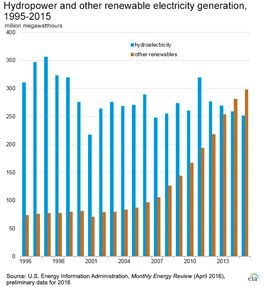Hydropower Basics
Energy from moving water

Source: Adapted from National Energy Education Development Project (public domain)
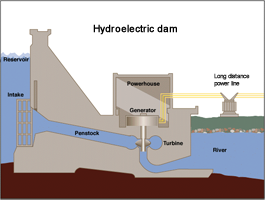
Source: Tennessee Valley Authority (public domain)
Hydropower generates electricity
Hydropower is the largest renewable energy source for electricity generation in the United States. In 2015, hydropower accounted for about 6% of total U.S. electricity generation and 46% of electricity generation from all renewables.
Because the source of hydroelectric power is water, hydroelectric power plants are usually located on or near a water source.
Hydropower relies on the water cycle
Understanding the water cycle is important to understanding hydropower. The water cycle has three steps:
- Solar energy heats water on the surface of rivers, lakes, and oceans, which causes the water to evaporate.
- Water vapor condenses into clouds and falls as precipitation (rain, snow, etc.).
- Precipitation collects in streams and rivers, which empty into oceans and lakes, where it evaporates and begins the cycle again.
The amount of precipitation that drains into rivers and streams in a geographical area determines the amount of water available for producing hydropower. Seasonal variations in precipitation and long-term changes in precipitation patterns, such as droughts, have a big impact on hydropower production.
Hydroelectric power is produced from moving water
The volume of the water flow and the change in elevation (or fall) from one point to another determine the amount of available energy in moving water. Swiftly flowing water in a big river, like the Columbia River that forms the border between Oregon and Washington, carries a great deal of energy in its flow. Water descending rapidly from a high point, like Niagara Falls in New York, also has substantial energy in its flow.
At both Niagara Falls and the Columbia River, water flows through a pipe, or penstock, then pushes against and turns blades in a turbine to spin a generator to produce electricity. In a run-of-the-river system, the force of the current applies pressure on a turbine. In a storage system, water accumulates in reservoirs created by dams and is released as needed to generate electricity. Watch a video about hydropower on the Bonneville Power Administration website.
History of hydropower
Hydropower is one of the oldest sources of energy for producing mechanical and electrical energy. Hydropower was used thousands of years ago to turn paddle wheels to help grind grain. Before steam power and then electricity were available in the United States, grain and lumber mills were powered directly with hydropower. The first industrial use of hydropower to generate electricity in the United States occurred in 1880, when 16 brush-arc lamps were powered using a water turbine at the Wolverine Chair Factory in Grand Rapids, Michigan.
The first U.S. hydroelectric power plant opened on the Fox River near Appleton, Wisconsin, on September 30, 1882.
For more information about hydropower, see Hoover Dam, a hydroelectric facility completed in 1936 on the Colorado River between Arizona and Nevada. this dam created Lake Mead, a 110-mile-long national recreational area that offers water sports and fishing in a desert setting.
Where Hydropower is Generated
Most U.S. hydropower capacity is in the West
More than half of U.S. hydropower capacity1 for electricity generation is concentrated in Washington, California, and Oregon. Washington has the most hydroelectric generating capacity of any state and is the site of the Grand Coulee Dam, the largest hydropower facility in the United States. New York has the largest hydroelectric capacity of all states east of the Mississippi River, followed by Alabama.
Most hydropower is produced at large facilities built by the federal government. The West has many of the largest hydropower dams. Many smaller facilities also operate around the country.
The share of U.S. total hydropower generation capacity by the top five states in 2015:
- Washington—27%
- California—13%
- Oregon—11%
- New York—6%
- Alabama—4%
Because the amount of electricity generation from hydropower depends on precipitation, the ranking of each state in annual hydroelectricity generation may be different from its ranking in generation capacity.
The share of U.S. total hydropower generation by the top five states in 2015:
- Washington—38%
- Oregon—13%
- New York—11%
- California—6%
- Alabama—4%
Most dams were not built for electricity generation
Only a small percentage of dams in the United States produce electricity. Most dams were constructed for irrigation and flood control and do not have hydroelectricity generators. The U.S. Department of Energy (DOE) estimated that in 2012, non-powered dams in the United States had a total of 12,000 megawatts (MW) of potential hydropower capacity.
1Net summer capacity for conventional hydroelectric power; does not include pumped storage hydropower.
Hydropower & the Environment
Hydropower generators produce clean electricity, but hydropower does have environmental impacts
Most dams in the United States were built mainly to control floods and to help supply water for cities and irrigation. Although many of these dams have hydroelectric generators, only a small number of dams were built specifically for hydropower generation. Although hydropower generators do not directly produce emissions of air pollutants, dams, reservoirs, and the operation of hydropower electric generators can affect the environment.
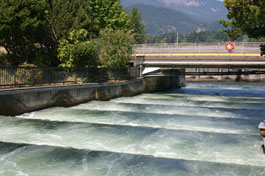
Source: Stock photography (copyrighted)
Did you know?
The Safe Harbor Dam on the Susquehanna River in Pennsylvania has elevators that lift migrating shad from the base of the dam to the top of the reservoir.
A dam that creates a reservoir (or a dam that diverts water to a run-of-river hydropower plant) may obstruct fish migration. A reservoir and dam can also change natural water temperatures, water chemistry, river flow characteristics, and silt loads. All of these changes can affect the ecology and the physical characteristics of the river. These changes may have negative impacts on native plants and on animals in and around the river. Reservoirs may cover important natural areas, agricultural land, or archeological sites. A reservoir and the operation of the dam may also result in the relocation of people. The physical impacts of a dam and reservoir, the operation of the dam, and the use of the water can change the environment over a much larger area than the area covered by a reservoir.
{/EE}Although no new hydropower dams have been built recently in the United States, they are being built in other countries like China. Manufacturing the concrete and steel used to construct these dams requires equipment that may produce emissions. If fossil fuels are used as the energy source to make these materials, then the emissions from the equipment could be associated with the electricity that hydropower facilities generate. However, given the long operating lifetime of a hydropower plant (50 years to 100 years) these emissions are offset by the emissions-free electricity that is generated. {/EE}
Carbon dioxide and methane may also form in reservoirs and be emitted into the atmosphere. The exact amount of greenhouse gases produced in hydropower reservoirs is uncertain. The emissions from reservoirs in tropical and temperate regions, including the United States, may be equal to or greater than the greenhouse effect of the carbon dioxide emissions from an equivalent amount of electricity generated with fossil fuels. Scientists at Brazil's National Institute for Space Research designed a system to capture methane in a reservoir and burn it to produce electricity.
Fish ladders help salmon reach their spawning grounds
Hydropower turbines kill and injure some of the fish that pass through the turbine. The U.S. Department of Energy has sponsored the research and development of turbines that could reduce fish deaths to lower than 2%, in comparison to fish kills of 5% to 10% for the best existing turbines.
There are many species of fish, such as salmon, that swim from the sea up rivers and streams to reproduce in their spawning grounds in the beds of rivers and streams. Dams block their way. Different approaches to fixing this problem have been used, including the construction of fish ladders and elevators that help fish move through or around dams to the spawning grounds upstream.
Tidal Power
Tides are caused by the gravitational pull of the moon and sun, and the rotation of the earth. Near the shore, water levels can vary up to 40 feet as a result of tides. The movement of water as a result of tidal forces can be used to produce energy.
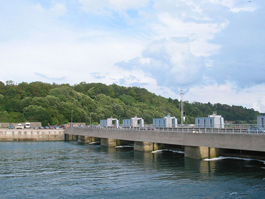
Source: Stock photography (copyrighted)
Tidal power is more predictable than wind energy and solar power. A tidal range of 10 feet is needed to produce tidal energy economically.
Tidal barrages
A simple system for tidal energy plants uses a structure similar to a dam called a barrage. The barrage can be located across an inlet of an ocean bay or lagoon that forms a tidal basin. Sluice gates (gates commonly used to control water levels and flow rates) on the barrage allow the tidal basin to fill on the incoming high tides and allows the tidal basin to empty through the turbine system on the outgoing ebb tide. There are two-way systems that generate electricity from both the incoming and outgoing tides.
A potential disadvantage of tidal power is the negative effect a tidal station can have on plants and animals in estuaries of the tidal basin. Tidal barrages can change the tidal level in the basin and increase turbidity (the amount of matter in suspension in the water). They can also affect navigation and recreation.
There are currently six tidal power barrages operating in the world. The largest is the Sihwa Lake Tidal Power Station in South Korea with a total power output capacity of 254 Megawatts (MW). The second-largest and oldest is in La Rance, France with 240 MW capacity. The next largest is in Annapolis Royal in Nova Scotia, Canada at 20 MW, and it is followed by the 3.7 MW Jiangxia Tidal Power Station in China, the 1.7 MW kilowatt tidal barrage in Kislaya Guba, Russia, and the 1 MW Uldolmok Tidal Power Station in South Korea.
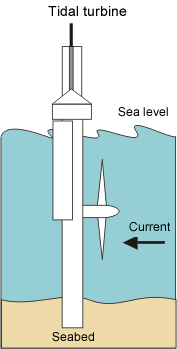
Source: Adapted from National Energy Education Development Project (public domain)
The United States does not have any tidal power plants, and it only has a few sites where tidal energy could be produced economically. France, England, Canada, and Russia have much more potential to use tidal power.
Tidal fences
Tidal fences can also harness the energy of tides. A tidal fence has vertical axis turbines mounted in a fence. All the water that passes is forced through the turbines. Tidal fences can be used in areas between two landmasses like channels. Tidal fences are cheaper to install than tidal barrages, and they have less impact on the environment than tidal barrages. However, tidal fences can disrupt the movement of large marine animals. A tidal fence is planned for the San Bernardino Strait in the Philippines.
Tidal turbines
Tidal turbines are basically wind turbines in the water that can be located anywhere there is strong tidal flow. Because water is about 800 times denser than air, tidal turbines have to be much sturdier than wind turbines. Tidal turbines are heavier and more expensive to build but capture more energy. There is an operating 1.5 MW tidal turbine in Strangford Lough, Scotland, and at Uldolmok, South Korea.
Wave Power
Waves have a lot of energy
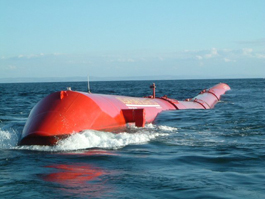
Source: Marine and Hydrokinetic Technologies Program, U.S. Department of Energy, Energy Efficiency and Renewable Energy (public domain)

Source: Adapted from National Energy Education Development Project (NEED).
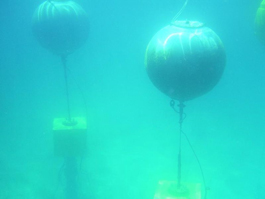
Source: Tuscanit, Wikimedia Commons author (GNU free documentation license) (public domain)
Waves are caused by the wind blowing over the surface of the ocean. There is tremendous energy in ocean waves. It is estimated that the total energy potential of waves off the coasts of the United States is 252 billion kilowatthours a year, the equivalent of about 6% of U.S. electricity generation in 2014. The west coasts of the United States and Europe, and the coasts of Japan and New Zealand, have good wave energy potential sites for harnessing wave energy because of wave energy potential.
Different ways to channel the power of waves
One way to harness wave energy is to bend or focus the waves into a narrow channel, increasing their power and size. The waves can then be channeled into a catch basin or used directly to spin turbines that generate electricity.
Many other methods of capturing wave energy are being developed. These methods include placing devices on or just below the surface of the water, and anchoring the devices to the ocean floor.
View wave technology currently being developed at the U.S. Department of Energy's Marine and Hydrokinetic Technology Database.
Ocean Thermal

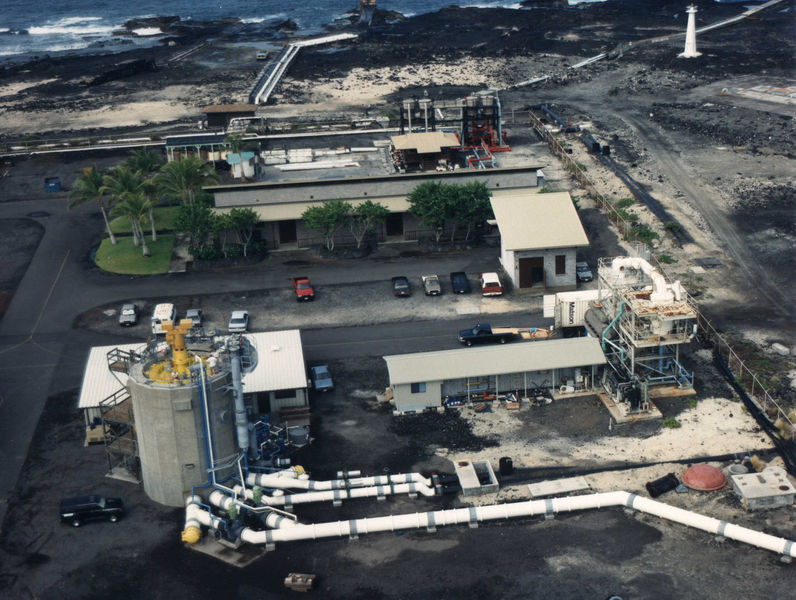
Source: U.S. Department of Energy (public domain)
Energy from the sun heats the surface water of the ocean. In tropical regions, surface water can be much warmer than deep water. This temperature difference can be used to produce electricity. The Ocean Thermal Energy Conversion (OTEC) system uses a temperature difference (of at least 77o F) to power a turbine to produce electricity.
The United States became involved in OTEC research in 1974 with the establishment of the Natural Energy Laboratory of Hawaii Authority. The laboratory is one of the world's leading test facilities for OTEC technology. The Natural Energy Laboratory and the U.S. Navy's Office of Naval Research supported the development of a 105 kilowatt demonstration OTEC plant in Hawaii.
No large-scale operation of OTEC exists today because of the many challenges associated with the technology. The U.S. Energy Information Administration does not project any generation of electricity with OTEC systems in the Annual Energy Outlook 2016, which has projections out to 2040.


